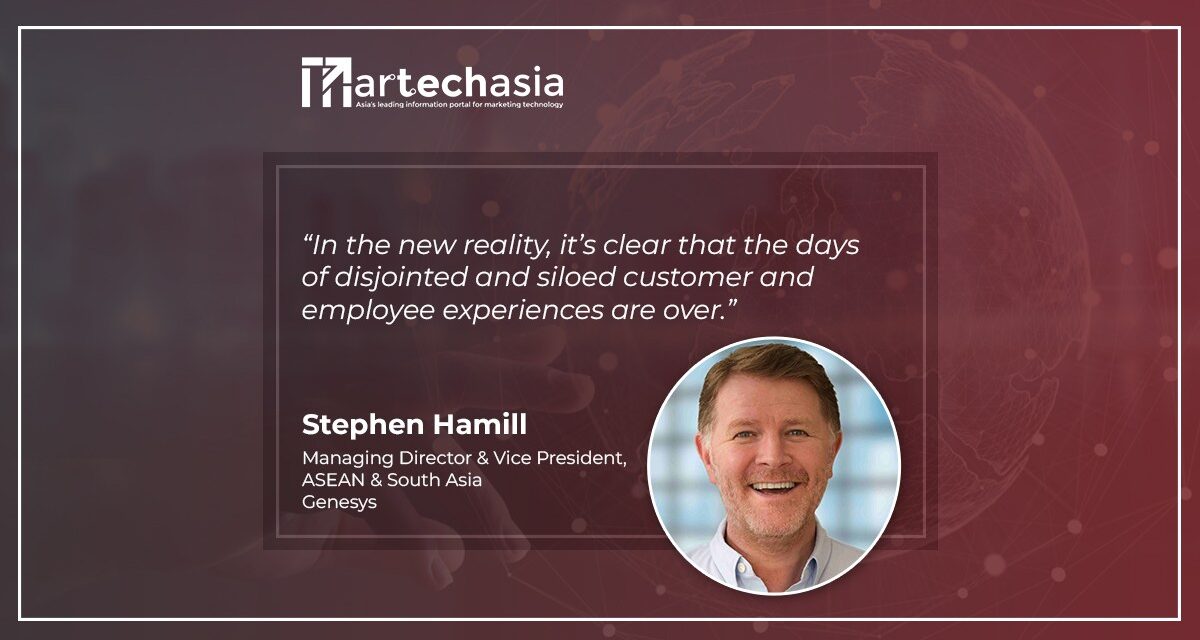The author shares his insights into the future of experience in Asia Pacific.
The abrupt arrival of COVID-19 has changed conventional rules of business in Asia Pacific. Facing considerable disruption arising from pandemic containment measures, organisations across the region turned to digitalisation and technology en masse in a bid to maintain business continuity.
Asia Pacific represents the world’s fastest-growing digital economy today. According to IDC, one in three companies will be generating more than 30% of their revenues from digital products and services by 2023. The unprecedented pace of digital transformation has catalysed a shift in consumer preferences which we foresee will have a far-reaching impact on Customer Experience (CX) in a digital-first reality.
So, what does the future hold for CX? From distributed workforces to the rise of digitally matured consumers, to businesses realising the value of emphatic experiences, here is our outlook on the key trends that will shape CX in the near term:
- Use of digital channels for customer interactions will surge
In line with rapid digitalisation taking root across the social and professional spheres, the number of consumers interacting with customer service through messaging, mobile apps, chatbots, social media and video calling, is on the rise.
A study by Genesys found that a majority of Asia Pacific’s businesses are prioritising the use of messaging apps such as WhatsApp and Facebook Messenger for customer service, believing that they will play a growing role in business-consumer interactions. 66% of businesses we surveyed indicated that they were already offering customer service through messaging apps, with another 20% stating that they were planning to integrate their customer service offerings on this channel within the next six months.
Consumer perspectives collected during our study determined that mobile messaging was by far the most popular digital channel among Asia Pacific’s consumers, followed by email and webchat. However, only 30% of consumers surveyed indicated that they were satisfied with the current state of customer service via digital channels, with traditional, voice-based channels remaining the most-used channel among the region’s consumers. To succeed in a digital-first economy, organisations will need to develop the right capabilities to orchestrate impactful CX via digital mediums.
- Speed and efficiency will be key to customer satisfaction
Genesys research has found customer satisfaction in Asia Pacific to be less contingent on price or availability, but instead on first contact resolution. Our study found that more than half of consumers in APAC placed a premium on a company’s ability to respond quickly and solve their issues at first interaction.
With consumers today believing a company is only as good as its customer service, it’s clear that CX can deliver significant business advantages when executed well. Businesses are increasingly recognising this, with CX having become a board-level priority for many organisations.
While we still often see customer facing functions operating in silos within organisations, this is set to change in 2022 and beyond, spurred by digitalisation. The growing number of digital touchpoints enables data to be collected across the entire customer journey, which yields valuable insights into personal preferences once analysed. By encouraging cross-collaboration across functions and equipping customer service agents with the right technologies, businesses can better orchestrate impactful customer experiences, delivering overall gains to the bottom line.
- Customers more focused on the business of ethics and sustainably
By shifting mindsets from viewing CX as a siloed function, to viewing the bigger picture of the overall reputation and image of a business, leaders will gain the perspective they need to make changes for the better.
For instance, businesses will need to be aware of the need to manage their social and environmental impact. Our study found that nearly a quarter of consumers surveyed said they would only buy from ethical and sustainable brands. Health and wellness, sustainable products/packaging, and carbon reduction rank among the top consumer values today.
Today, we are seeing more customers in Asia Pacific being increasingly inclined to hold companies accountable with their spending power. Brands that have an honest, authentic, and empathetic approach to business will come out on top.
- Empathy will need to be placed at the centre of customer experience
Loyalty is fuelled by listening. This was made apparent in the results of our study, where nearly all consumer respondents scored a business’ ability to listen as their most important attribute. When consumers in Asia Pacific feel they’ve had a personalised experience, more than 80% said they would purchase additional or repeat items, becoming brand advocates in the process and recommending the company to others.
When businesses create engagements based on empathy, customers feel remembered, heard, and understood. This in turn leads to better connections, loyalty, and business results. However, to get there it’s important to strike the balance between the right combination of technologies, and human touch, to show each customer empathy, while still being able to deliver at scale.
By implementing the right technology to enable a personalised, contextually relevant experience to each customer, companies will be able to better orchestrate customer journeys to lead a culture shift towards empathy. Our vision is in ‘Experience-as-a-Service’ – the practice of an organisation putting empathy at the centre of each customer’s experience. Enabled by cloud, AI, data, and engagement channels, it has become possible for organisations today to deliver a higher level of personalisation, while still being efficient in delivery.
- Employee experience will become the next battleground for CX
In the coming year, we also foresee the need to orchestrate impactful experiences extending beyond the customer to also include the employee.
Over the years, organisations have shifted focus from putting customers at the centre, then employees, and swinging back and forth between the two. But if recent times have taught us anything, it is that the two are intrinsically linked, and one cannot exist without the other. In fact, Accenture found that organisations can increase year-on-year profitability by six times when focusing on not just CX, but how experience ties back to every aspect of a company’s operations.
With many organisations adopting remote workforces since the pandemic, coupled with challenges brought about by ‘The Great Resignation’, a focus on employee experience has never been more important – and so businesses need to have a strategic focus on employee experience (EX) moving forwards through workforce engagement tools, including providing greater flexibility on how employees want to work, encouraging collaboration through availability of digital platforms, and employing modern technologies such as Cloud and Artificial Intelligence (AI) to elevate work beyond the mundane, to being more strategic.
By focusing on the engagement and satisfaction of their own employees, businesses will find this becomes a leading indicator for differentiated customer satisfaction by default.
In the new reality, it’s clear that the days of disjointed and siloed customer and employee experiences are over. While the future of CX for an organisation can be determined by industry megatrends such as digital maturity and landscape changes, rapid digital transformation of Asia Pacific’s business landscape holds tremendous promise to vastly enhance CX as we know it. Aligning strategies towards a unified channel agnostic experience, prioritising the employee on the same level as the customer, harnessing new technologies such as Cloud and AI, and above all, displaying the ability to listen to specific needs, can empower organisations with the ability to orchestra impactful CX that resonate with today’s audiences, enabling them to maintain their competitive edge over the competition.


















